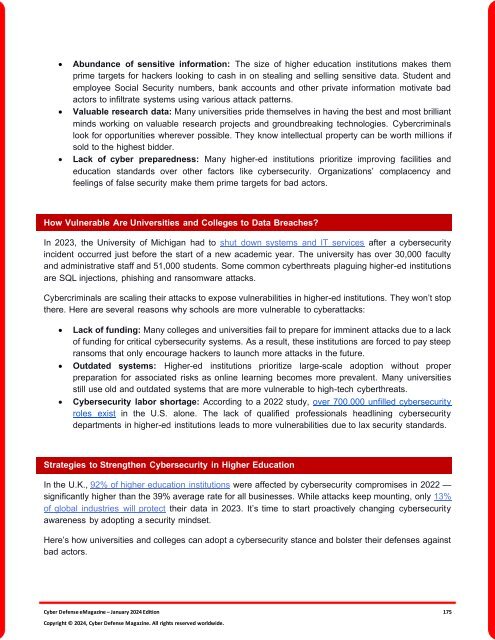The Cyber Defense eMagazine January Edition for 2024
Cyber Defense eMagazine January Edition for 2024 #CDM #CYBERDEFENSEMAG @CyberDefenseMag by @Miliefsky a world-renowned cyber security expert and the Publisher of Cyber Defense Magazine as part of the Cyber Defense Media Group as well as Yan Ross, Editor-in-Chief and many more writers, partners and supporters who make this an awesome publication! 201 page January Edition fully packed with some of our best content. Thank you all and to our readers! OSINT ROCKS! #CDM #CDMG #OSINT #CYBERSECURITY #INFOSEC #BEST #PRACTICES #TIPS #TECHNIQUES
Cyber Defense eMagazine January Edition for 2024 #CDM #CYBERDEFENSEMAG @CyberDefenseMag by @Miliefsky a world-renowned cyber security expert and the Publisher of Cyber Defense Magazine as part of the Cyber Defense Media Group as well as Yan Ross, Editor-in-Chief and many more writers, partners and supporters who make this an awesome publication! 201 page January Edition fully packed with some of our best content. Thank you all and to our readers! OSINT ROCKS! #CDM #CDMG #OSINT #CYBERSECURITY #INFOSEC #BEST #PRACTICES #TIPS #TECHNIQUES
Create successful ePaper yourself
Turn your PDF publications into a flip-book with our unique Google optimized e-Paper software.
• Abundance of sensitive in<strong>for</strong>mation: <strong>The</strong> size of higher education institutions makes them<br />
prime targets <strong>for</strong> hackers looking to cash in on stealing and selling sensitive data. Student and<br />
employee Social Security numbers, bank accounts and other private in<strong>for</strong>mation motivate bad<br />
actors to infiltrate systems using various attack patterns.<br />
• Valuable research data: Many universities pride themselves in having the best and most brilliant<br />
minds working on valuable research projects and groundbreaking technologies. <strong>Cyber</strong>criminals<br />
look <strong>for</strong> opportunities wherever possible. <strong>The</strong>y know intellectual property can be worth millions if<br />
sold to the highest bidder.<br />
• Lack of cyber preparedness: Many higher-ed institutions prioritize improving facilities and<br />
education standards over other factors like cybersecurity. Organizations’ complacency and<br />
feelings of false security make them prime targets <strong>for</strong> bad actors.<br />
How Vulnerable Are Universities and Colleges to Data Breaches?<br />
In 2023, the University of Michigan had to shut down systems and IT services after a cybersecurity<br />
incident occurred just be<strong>for</strong>e the start of a new academic year. <strong>The</strong> university has over 30,000 faculty<br />
and administrative staff and 51,000 students. Some common cyberthreats plaguing higher-ed institutions<br />
are SQL injections, phishing and ransomware attacks.<br />
<strong>Cyber</strong>criminals are scaling their attacks to expose vulnerabilities in higher-ed institutions. <strong>The</strong>y won’t stop<br />
there. Here are several reasons why schools are more vulnerable to cyberattacks:<br />
• Lack of funding: Many colleges and universities fail to prepare <strong>for</strong> imminent attacks due to a lack<br />
of funding <strong>for</strong> critical cybersecurity systems. As a result, these institutions are <strong>for</strong>ced to pay steep<br />
ransoms that only encourage hackers to launch more attacks in the future.<br />
• Outdated systems: Higher-ed institutions prioritize large-scale adoption without proper<br />
preparation <strong>for</strong> associated risks as online learning becomes more prevalent. Many universities<br />
still use old and outdated systems that are more vulnerable to high-tech cyberthreats.<br />
• <strong>Cyber</strong>security labor shortage: According to a 2022 study, over 700,000 unfilled cybersecurity<br />
roles exist in the U.S. alone. <strong>The</strong> lack of qualified professionals headlining cybersecurity<br />
departments in higher-ed institutions leads to more vulnerabilities due to lax security standards.<br />
Strategies to Strengthen <strong>Cyber</strong>security in Higher Education<br />
In the U.K., 92% of higher education institutions were affected by cybersecurity compromises in 2022 —<br />
significantly higher than the 39% average rate <strong>for</strong> all businesses. While attacks keep mounting, only 13%<br />
of global industries will protect their data in 2023. It’s time to start proactively changing cybersecurity<br />
awareness by adopting a security mindset.<br />
Here’s how universities and colleges can adopt a cybersecurity stance and bolster their defenses against<br />
bad actors.<br />
<strong>Cyber</strong> <strong>Defense</strong> <strong>eMagazine</strong> – <strong>January</strong> <strong>2024</strong> <strong>Edition</strong> 175<br />
Copyright © <strong>2024</strong>, <strong>Cyber</strong> <strong>Defense</strong> Magazine. All rights reserved worldwide.

















